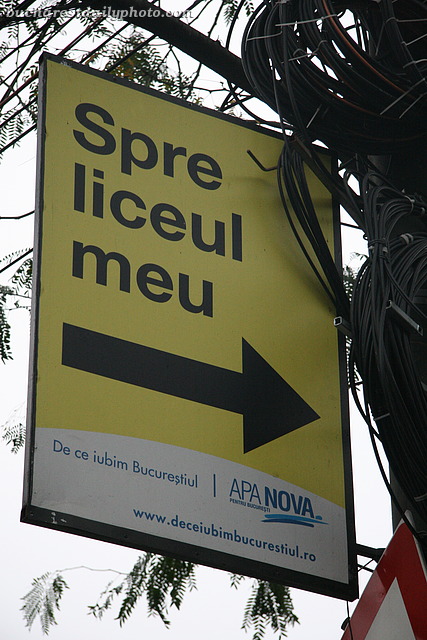About two years ago Bucharest’s water supply company, “Apa Nova”, initiated a social advertising campaign titled “Why we love Bucharest”, meant to make the citizens of Bucharest feel a little better about living in this crazy and chaotic city. As part of their campaign there were signs posted all over the city reading “This is where I went to my first party”, “The street where I first kissed Ana” or “The street where I rode my first bicycle” etc. Some of these ads actually looked like street signs and a friend told me that he saw a pair of confused Germans tourists trying to find the “Street where my grandma lived” on a map – without being successful, of course 🙂 I liked the campaign and meant to photograph some of the signs but I was away from Bucharest for some time and when I returned the campaign was over and the signs were removed. But yesterday I was strolling on Ştirbei Vodă Street and run into this sign, left here probably from two years ago. The sign reads “The way to my high school”.
Oct 062009

This is funny and a good idea, if it worked I am not able to say!
I don't know if it worked, most of the people I know like to complain about living here. But Romanians like to criticize in general and you don't have to believe everything they're saying 🙂
Haha! I guess it would be a problem if you were a tourist and didn't understand the signs were part of a campaign to foster civic pride.
The first thing that comes to my mind is, why the heck does a private water supply company start such an image campaign for Bucharest? What's their benefit in this? I would have expected this from the city council. This is a sweet idea, though.
To be honest, I have no idea what they gain by it. Probably advertising opportunities and maybe some tax cuts? I know they are also involved in some environmental programs.
Not sure if this is relevant, but maybe…..
Ocazie prima, odata – Bucureşti
Bob Jarvis
I landed at Otopeni Airport in the dark cold of a Sunday night and, advised by a fellow traveller with a ten hour train journey ahead of him to Iasi not to trust the taxi drivers , sought the 7 lei bus trip into the city from the basement of the domestic arrivals terminal . I had arrived in Romania :‘Beware – the mafia will rob you, the gypsies stab you and the wild dogs eat your body’
As my bus crawled along the blue Christmas lit tree lined outer arterial where new apartment blocks covered in agents’ boards were spaced between retail ‘outlets’ , through the dark parklands of Baneasa and towards the Arc de Triumf (the first recognisable landmark – except that its in the centre of a huge gyratory) and then along boulevards of jugendstyl villas, and past the dark six storey blocks of department stores and flats I could have been in Lille or Lyon. Except the next stop indicator now read ‘Piata 21 Dec 1989 / Metro Universitatii’ – and if you know anything about recent Romania ‘21 Dec 1989’ is a date you don’t forget. And just to prove this is the new post Ceausescu Romania a huge electric Christmas tree is gradually changing colour at its centre.
Daylight, a grey even cold grey drizzle daylight, confirmed the eclectic fragmented collage that is post modern post communist Bucureşti. Outside my restored two star suite in a one star hotel (‘Roman Style’ with two balconies) a 1960’s concrete frame office butted into a converted French grande maison and on the corner an unfinished swoop of exaggerated curved purple steel cut through the flapping sheeting of an unfinished speculation above the row of one room, one light bulb, one loaf of bread corner shops – the history of the city before I’d even started out
In three, snowy days – not that -8 degrees and about 15cms. of snow did much to stop the traffic despite ungritted roads (raising questions of corruption on the local TV) – it was only possible to see a fraction of the city, but still it confirmed that first balcony impression of (and reinforced my love for) this crazy collage of a city. For that is what it is : Rowe and Koetter’s theory made real twenty five years after it was written, combined with a discarded set for Blade Runner
Can such a place as Bucureşti, have such a fragile spirit as the genius loci when its been : transformed out of a trading post in the 19th century; made into the ‘Paris of the East’ in the 1920’s; the model of rationalist state communism in the 1950’s ; a megalomaniac’s dream in the 1970’s; and now in the grip of free market expressionism (with some token conservation) ; and if I read between the lines of my budget airline magazine and my Thomas Cook City Spot Guide :‘lets be honest, you probably aren‘t coming for the sights. Instead most people come for the energy ….the skyscrapers that appear from nowhere and the trendy night spots that attract the finest DJ‘s in the world’ – the next international party city ?
The combination between the unfettered dynamism of commercial and speculative development, the relatively new planning system and the fragility of the historic townscape suggests a metaphor somewhere between riding a rodeo steer and a bull in a china shop. But I want to be there.
Anonymous (Bob Jarvis): I would say this is the best portrait of Bucharest I've read in a while. A crazy collage with a lot of energy. Great writing.